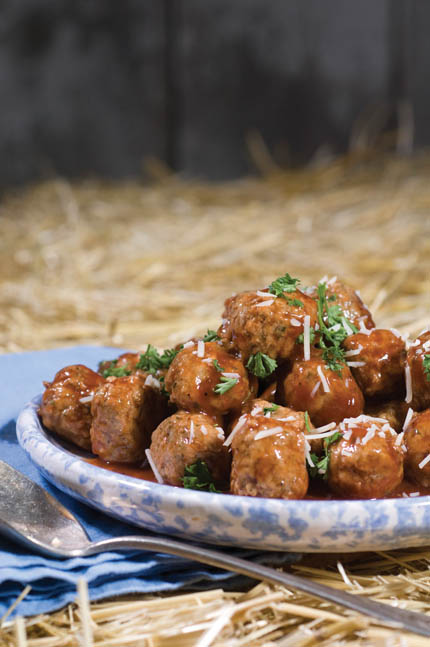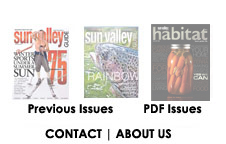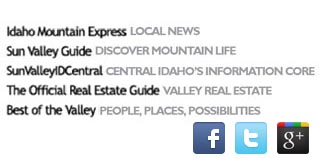The meat of the matter
Why the origin of food affects its value to the consumer
text by Dana DuGan photos by Paulette Phlipot
Before lifting fork to mouth, mull the origin of that juicy steak. Did that cow once graze happily under the Idaho sun or are its origins unknown?
Those interested in the growing food revolution make it a point to know the source of their food. They demand their foods be organic, local, seasonal and sustainable, for their health, the health of their community and the health of the local economy.
Author, nutritionist and professor Marion Nestle lays it out on her website, FoodPolitics.com: "Organic means crops grown without artificial pesticides, fertilizers, GMOs, irradiation, or sewage sludge, and animals raised without hormones or antibiotics. Local food refers to food grown or raised within a given radius. Seasonal refers to food plants eaten when they are ripe. Sustainable means the nutrients removed from the soil by growing plants are replenished without artificial inputs (fertilizer)."
A resurgence in procuring naturally produced local meat products—for their richer taste and lack of chemicals, and for the benefit of the farmers—is sweeping the nation. "When you buy from your local farmers, it keeps the whole fabric of the community together," said Kathleen Bean of Idaho-based Lava Lake Land & Livestock.
Feedlots, where animals are penned in, fed almost exclusively grain and treated with antibiotics due to the stress of the conditions, are out for health-conscious farmers and consumers. Instead, organic farmers keep animals on the range where they forage on healthy, diverse pastureland.
A major benefit of raising pastured animals is a healthier animal and thus healthier meat. Studies from the Journal of Animal Sciences and from Colorado State University, among other sources, report that compared with conventionally raised feedlot meat, grass-fed animals have less fat, cholesterol and calories, and they contain more vitamin E, beta-carotene, vitamin C, omega-3 fatty acids and conjugated linoleic acid (CLA).
Internationally renowned food writer Michael Pollan chooses pasture-raised meats. He explained his choice in a 2011 New York Times article: "In meat, organic is very expensive, and doesn't necessarily ensure that the animals didn't live on feedlot. I look for grass-fed for beef instead; milk and butter, too."
He also adheres to a local diet, as much for the health of the environment as for his own health. After all, meat requires a lot of energy to produce. "Among the carbon footprint aspects of the industrial food system are chemical fertilizers (made from natural gas), pesticides (made from petroleum), farm machinery, modern food processing and packaging and transportation," he wrote.
Another angle to Pollan's argument is that "the top 10 killers in America today are chronic diseases linked to diet: heart disease, stroke, Type 2 diabetes and cancer. … While the surfeit of cheap calories that the U.S. food system has produced since the late 1970s may have taken food prices off the political agenda, this has come at a steep cost to public health."
It's all connected.
Idaho has a wealth of believers made up of farmers and consumers alike.
Ed Wilsey's ranch near Marsing, Idaho is part of Homestead Natural Foods. His personal story illustrates why the nutritional aspect is so important. "About eight years ago, I had health issues. Doctors nearly killed me with all the poking and steroids and statin drugs. We did a little research, and we got into health food. I said to my wife, 'Why aren't we doing this?' So we started doing grass-raised beef."
And his health? "I'm still here," he said with a chuckle, "Though I'm trying to find the fountain of youth."
But it wasn't just Wilsey's concerns that led to a greener Homestead. His partner in the company, Keith Huettig, owns Bar H Cattle Co. in the Magic Valley. He also chose to do his own research due to a diagnosis of cancer.
Forgoing conventional Western chemotherapy and radiation, he opted instead for a total nutrition program and is now in remission. "Grass-fed beef, pork and chicken raised with sustainable agricultural practices may cost more, but like our grandparents would have told you back in the day, you get what you pay for," he said. "And when it comes to your health, isn't that worth a little extra?"
It wasn't just health that convinced the partners to change their ranching ways, however. "I've been a commodity rancher my whole life," Wilsey said. "[The commodities markets] dictate to you what kind of cattle [you breed], and you're up against it the whole time. We got burned out."
The Homestead cattle, pigs and poultry are all grass-fed and finished without hormones or antibiotics. "Why buy local?" Wilsey asked. "Because every dollar spent locally multiplies nine times. I know it makes a big difference when you buy local produce from farmers—money stays in the community."
Other converts to the life of locally raised meat are Mitch Lucero and his wife, Acee, who raise Heritage turkeys at their A+ Ranch in Richfield.
Acee's father, Alan Lauder, who passed away in September 2008, owned the free-range turkey farm. "He processed them himself, loaded them and spent a day visiting his friends and giving them away," Lucero said.
When he died, the Luceros were left with hundreds of turkeys. "We thought, 'What do we do now?' We had no idea," Lucero said.
They decided to have the farm certified by the USDA Organic Certification Program. "What you put into the ground you get out of it," he said. "That is a belief and a passion we've adopted and implemented on the farm. We raise a portion of our grain on our farm—it's biodynamic. It all goes back into the land."
Now A+ turkeys can be found in restaurants in Boise and the Wood River Valley, and in local food stores.
"Do you know where your food comes from and what's been put into that piece of meat you're eating?" Lucero asked. "People haven't been educated on what it takes to grow an animal. Mostly it's to produce a better yield, not a better product. It comes down to the dollar, and to prolong the shelf life. We believe in the opposite—producing a wholesome product."
Lava Lake Land & Livestock's owners, Kathleen and Brian Bean, produce grass-fed lamb while protecting the land they use in the Pioneer Mountains region near the Snake River Plain. "Eating locally is really important," Kathleen said. "Having said that, we do ship our lamb all over the country, but that's because we grow the best lamb in the country."
And consumers across the country are increasingly demanding better quality. "I'm speaking for all local producers in saying that it's a really basic way of raising animals," Brian said. "The lambs are eating nothing that Mother Nature didn't intend. They spend their lives with their mothers and in new pastures everyday."
Today, it's responsible to know how food is raised. "There is plenty of evidence that grass-fed is a really healthy way to eat," Brian said. "We're used to buying cheap food in this country. My feeling is you should eat less, and buy better quality."
Kathy Carlson, who handles marketing for the Agri Beef Co. in Boise, says her company has a different game plan from those who adhere to the strict locavore standard. "It's an opportunity conundrum," she said. "We're a local company, but our idea of local is the Pacific Northwest. It's a sharing of resources, best utilized to replenish and support local economies. Our cattle are processed in central Washington, so it's a fairly small carbon footprint."
The Agri Beef Co. has four major brands, including Snake River Farms in southeastern Idaho. The farm is surrounded by hundreds of acres of fertile land supplying a steady diet of potato, barley, wheat and high-moisture corn for the animals.
"Our customers and clients are more educated because of the green movement," Carlson said. "They're taking more notice of where their food comes from, and they want to support their local economies and communities. When we all work together, we all work better." While not certified organic, Agri Beef's products are handled with extreme attention to quality.
Joan Marsted, of Panther Ranch in Donnelly, is a stockbroker from California who, when her friends were buying beachfront property for their retirement, opted for a cattle ranch in Valley County, Idaho, instead. "We don't use hormones or anything like that," she said. "A lot of people put cattle on wheat. We don't. We rototill oats and barley into pastures, where our cows are pasture-raised then finished with corn, because it puts marble in them."
Her number one reason for selling her beef locally is to support the community. "We sell at the McCall Farmers' Market, through the Idaho Mountain Express newspaper and our website."
It's going to cost more, but the arguments for buying local and healthy outweigh the cost issues time after time. Buying local supports farmers in the state, contributes to the economic health of the local area and creates jobs. It means eating healthier and making informed choices.
It's a good taste all the way around.
|

Moroccan-
style Lamb Meatballs in Yogurt Sauce
Spice Mixture
1 T. ground coriander, toasted
1 T. ground cumin, toasted
1 T. garlic powder
1 t. onion powder
1 t. dried oregano
1 t. dried thyme
1 t. ground mustard
½ t. paprika
½ t. ground allspice
½ t. ground cinnamon
½ t. chili powder
1 t. salt
black pepper
Mix spices together thoroughly
Meatballs (makes 60-65)
2.25 lbs ground lamb
6 dried apricots, minced
¼ c. dried sour cherries, minced
zest of two lemons
2 eggs, lightly beaten
½ c. bread crumbs (fine)
Put all of the above in bowl, add spice mix and mix thoroughly. Refrigerate for an hour for flavors to meld; cover to prevent drying.
Make into 1" balls, bake at 425 degrees for 18-19 minutes. Serve at room temperature with yogurt sauce for dipping.
Yogurt Sauce: Mix 1 cup whole milk yogurt with the juice of one lemon

|




